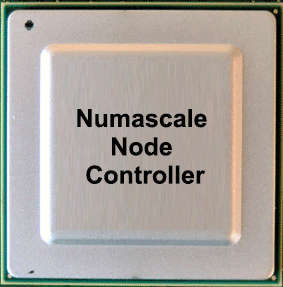Scale-Up Technology for large servers
Scale-Up systems connect multiple CPUs to form larger systems where all processes can share all resources; memory, processing cores, I/O and storage. Scale-up systems with Numascale’s NumaChip-3 can be configured to support 8 to 32 CPUs in a single system under one instance of the operating system. A higher number of CPUs constitutes a larger system with correspondingly larger memory to handle applications with large memory and compute requirements. Among the applications that benefit from Scale-Up systems are SAP/Hana, transactional databases, scientific simulations, Advanced Analytics, Real-time Streaming, AI (ML, DL), etc. A common requirement for all of those applications is to have access to large amounts of memory across the CPUs (sockets) with system-wide cache coherency.
Scale-Out or Horizontal Scaling (Distributed connection of servers over many compute nodes)
Scale-Out is a distributed computer architecture. Typically, a compute node consists of 2-4 CPU sockets. A number of such nodes are then horizontally connected in non-cache coherent way through a network fabric. The memories are not visible across nodes. It is not possible to obtain a single memory image (across sockets) as is the case with Scale-Up systems. This will limit throughput and capacity for all applications that are memory “hungry” and compute intensive.
Scale-Up Advantage
Annual cost for Scale-Up servers vs. Scale-Out servers in a selected environment for a given number of users, have the following advantages according to IDC:
Productivity Improvement – simpler application development
Reduction in IT personnel – fewer individual machines to manage and maintain
Power and Facilities improvement – better utilization of resources
Server and Network improvement – fewer network fabric ports and switches
Software efficiency improvement – tighter coupling between processes
Overall TCO savings
Scale-Up Server Products
For large data centers, the number of individual machines can be reduced with an order of magnitude by moving from 2CPUs per node to 16-32 CPUs. System vendors can build high-end Scale-Up systems with Numascale node-controllers and offer significant reduction in datacenter TCO for their customers.
Roadmap
The NumaChip-3 node-controller is compatible with Intel’s UPI1.0 interface. Numascale is now developing the next generation node-controller to match with Intel’s roadmap for use with the next generation UPI 2.0 technology.
NumaChip-3 for Intel Ultra Path Interconnect 1.0
NumaChip-3 High Level Specifications
Overview:
Innovative Shared memory, Scalable, Cache Coherent System Interconnect Architecture
Supports high-end 2nd Generation Intel® Xeon® Scalable Processors (Purley and Whitley Platforms) processor nodes
Supports Intel Ultra Path Interconnect 1.0 (UPI 1.0) technology
ASIC implementation capable of supporting (2S, 4S, 8S, 16S, 32S) system configurations
Scalability:
Supports up to 11.2 GT/s full-width data-rate per UPI port
Performance improvement through full-directory snoop filter architecture
2-UPI ports for connecting to CPUs
8 interconnect ports for connecting to other dual-CPU nodes, each port carries the full UPI bandwidth
Supports two parallel data-planes by doubling the number of UNCs per system
Security:
Superior RAS capabilities
ECC protection on all important data structures (payload buffers, snoop filter, snoop filter cache, microcode instruction storage)
Support for viral and poison state mechanisms for handling error propagation and graceful shutdown

